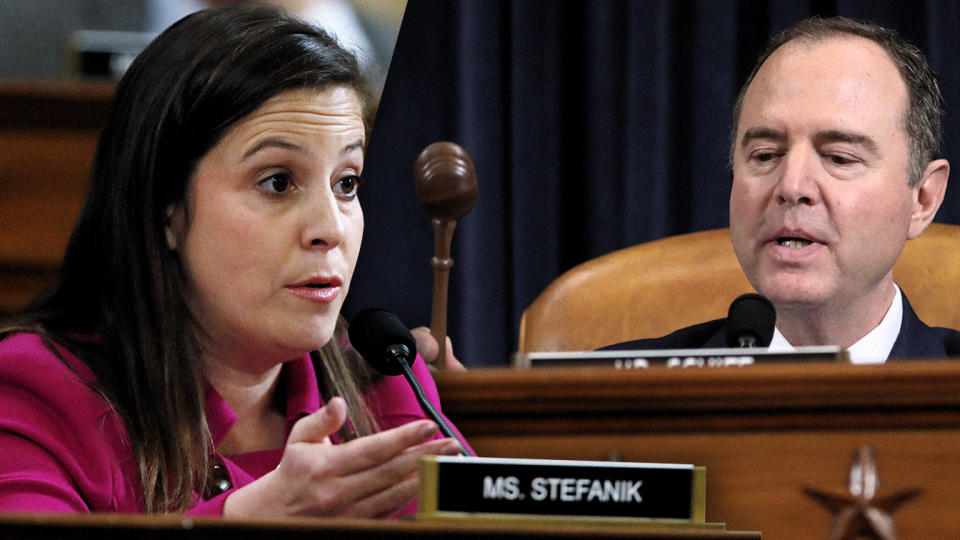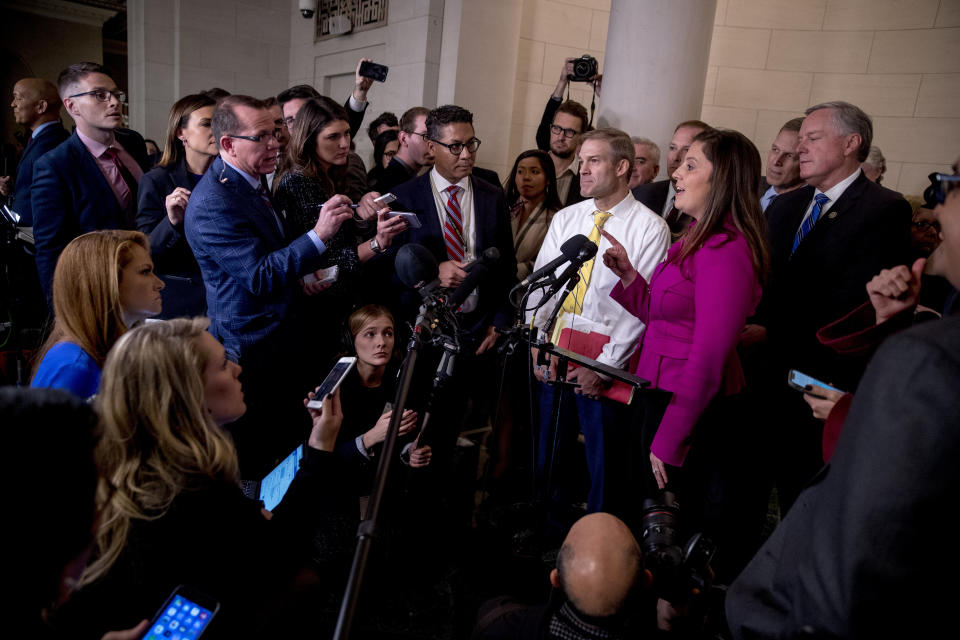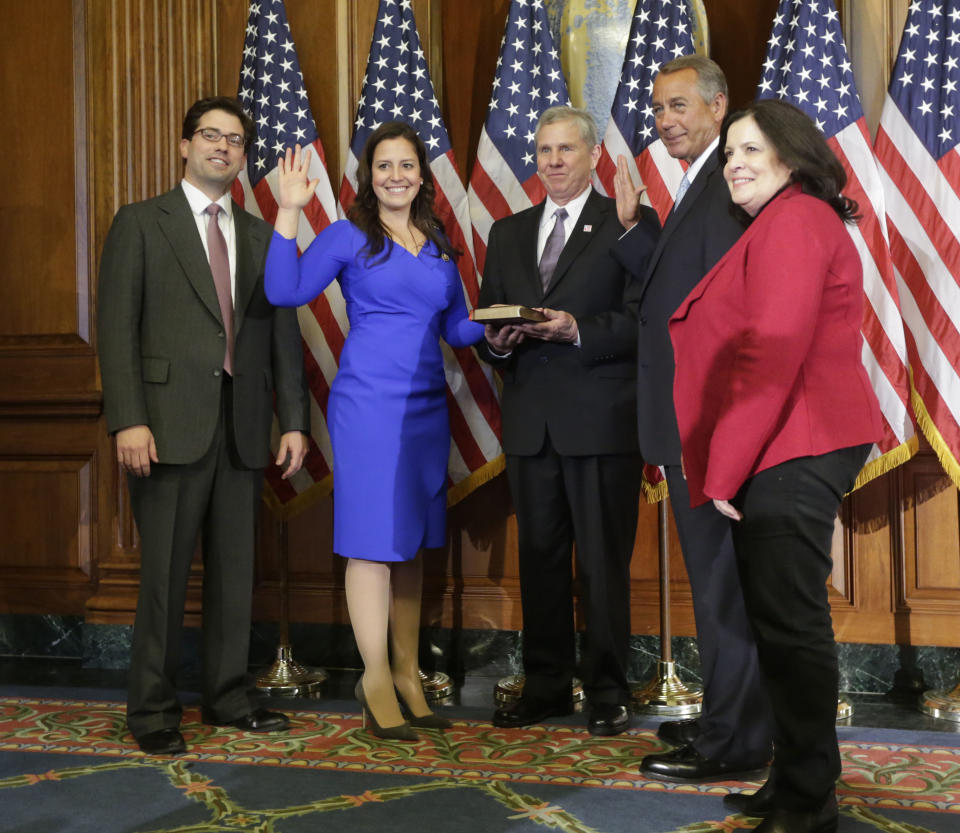Stefanik embraces spotlight at impeachment hearings
- Oops!Something went wrong.Please try again later.
The second day of the impeachment inquiry’s public hearings, on Friday, began the same way as the first: with an attempt by Rep. Elise Stefanik, a New York Republican, to interrupt proceedings with a procedural objection.
Stefanik accused House Intelligence Committee Chairman Adam Schiff, D-Calif., of shutting down Republican questions, prompting Schiff to bang his gavel and declare her objection out of order.
Stefanik again engaged in theatrics later in the hearing, forcing Schiff to gavel down her attempt to break the rules of the hearing and ask questions of the witness before it was her turn.
“What is the interruption for this time?” Stefanik snapped at Schiff, turning to glare at him.
Schiff again explained the rules: Only Rep. Devin Nunes, R-Calif., and his legal counsel Steve Castor were authorized to ask questions during the first 45 minutes of Republican questions, just as only Schiff and his legal counsel Daniel Goldman were allowed to ask questions during their first 45 minutes.
And after the hearing was over, Stefanik — standing at the front of a group of Republicans who spoke to a large crowd of reporters — talked about the hearing in sharply partisan terms and offered misleading statements about the rules governing it.
“This was Day 2 of an abject failure of Adam Schiff and his regime of secrecy,” Stefanik said. She accused Schiff of “making up the rules as he goes” because he “did not let us control our own time.”
The rules for the hearings were laid out and voted on by the full House on Oct. 31, and have been written about in the press.

This week appeared to mark a surprising turn for the 35-year-old upstate New Yorker, who until recently was best known as a relative moderate who went to Harvard, worked for President George W. Bush and had taken on members of her own party who dismissed her criticisms of the GOP for its lack of female representation in the House.
It appears, as one longtime admirer of hers put it, that Stefanik has “gone the full MAGA,” a shorthand for those who become all-in supporters of Trump and his Make America Great Again movement.
One close observer of the congresswoman noted that “her profile is definitely on the rise, and with the number of retirements among senior house [Republicans], she’s positioned to seize a leading role in the very near future.”
This week she already played that role. In addition to her attention-grabbing confrontations in the hearings, she’s been singled out by Rep. Jim Jordan, the Ohio Republican who is effectively quarterbacking the Republican defense of the president during the impeachment hearings, to be his most outspoken sidekick when addressing reporters.
Both on Wednesday and on Friday, when Jordan and a group of several other Republicans went to speak to a bank of TV cameras, Stefanik stood next to him and was the first to speak after him. She battled with reporters on Friday who pressed her to defend Trump’s tweet attacking Marie Yovanovitch, the former U.S. ambassador to Ukraine.
“We’re not hear to talk about tweets. We’re here to talk about impeachable offenses,” Stefanik said.

However, earlier in the day, Stefanik had criticized Trump for his tweet. That small break with the president was a glimmer of the independence that Stefanik has primarily been known for, until recently.
She was first elected to Congress in 2014, to a district in upstate New York that stretches from the northern suburbs of Albany all the way to the Canadian border, whose residents had voted for Democratic presidents six elections in a row. In addition, the district had elected a Democrat to represent it in the House for almost all of the previous century, interrupted only by a 10-year stretch from 1983 to 1993, and by a seven-year stretch beginning in the late 1940s.
The district elected Barack Obama twice, but his margin of victory was far slimmer in 2012 over Republican Mitt Romney — 52 to 46 percent — than the 58-to-40 rout that Obama enjoyed over Republican John McCain in 2008.
That was a sign of things to come. Two years after Stefanik was first elected, her district supported Trump 54 to 40 percent over Democrat Hillary Clinton in 2016. The district is overwhelmingly white and non-college-educated, two of the defining characteristics of the average Trump supporter.
And yet in 2016, Stefanik was still catching up to the changes afoot. She refused to endorse anyone during the Republican presidential primary, drawing fire from New York Republican Carl Paladino, who was part of the Trump campaign.

Paladino publicly called for someone to mount a primary challenge to Stefanik from the right and called her a “Washington elitist establishment sell-out.”
After Trump secured the Republican nomination, she tried to straddle a line between criticizing Trump when she disagreed with him while supporting him as the party’s nominee — a balancing act similar to that of many other Republicans for whom Trump was not only not their first choice, but probably their last.
“I’m supporting my party’s nominee. But I’ll continue being an independent voice for the district,” she said in the fall of 2016.
Stefanik was from the establishment wing of the Republican Party. In the Bush administration she worked for the second-term White House chief of staff, Joshua Bolten. During the 2012 election she worked for moderate Republican Tim Pawlenty, the former governor of Minnesota. She later worked during that election on helping run debate prep for Paul Ryan, the Wisconsin Republican who was Romney’s running mate and went on to become speaker of the House and one of Trump’s most prominent rivals and critics inside the GOP.
After the 2018 primaries, Stefanik drew national attention when she clashed with Republican leaders over the dwindling number of women inside the House GOP. An already low number of 23 female Republican House members shrank to just 13 after the midterms, prompting Stefanik to withdraw her participation from the National Republican Congressional Committee, where she had been head of candidate recruitment.
Instead she decided to form her own leadership PAC aimed at recruiting Republican women to run for office. But the incoming head of the NRCC, Tom Emmer, R-Minn., criticized her decision. “If that’s what Elise wants to do, then that’s her call, her right,” Emmer told Roll Call. “But I think that’s a mistake.”
Stefanik put Emmer on blast, sending out a tweet with four red siren emojis to highlight her retort to him: “But🚨🚨NEWSFLASH🚨🚨I wasn’t asking for permission.”
“I will continue speaking out about the crisis level of GOP women in Congress & will try to lead and change that by supporting strong GOP women candidates through my leadership PAC,” she said in a subsequent tweet.
It’s that fearlessness when it comes to political combat that Republicans are now utilizing in making Stefanik one of their most public faces. She is also the only Republican woman on the House Intelligence Committee, and so she presents a different face to the country than the typical white male.

“I think it’s a strategy from her side of the aisle,” Rep. Val Demings, D-Fla., told Yahoo News. “Maybe there’s some belief that the public will look in a less negative way if it’s a woman leading that aggressive effort.”
Stefanik has drawn praise as well for her effective questioning in the brief moments she has been allowed by the rules to interrogate witnesses.
But her theatrics have also been used as a tool by partisans online in the battle for public opinion. Katie Pavlich, a conservative commentator, tried to mitigate the damage done by Trump’s tweeted attacks on Yovanovitch, pointing to the exchange between Schiff and Stefanik.
“Adam Schiff silences a female member of Congress who tries to question a female witness. So, when you hear the narrative that Republican men bullied a female witness, don’t buy it,” Pavlich tweeted.
Of course, Republicans and Democrats alike understood the rules and knew that only Schiff, Nunes and their respective counsels could ask questions during the 90-minute blocks. Only after the 90-minute rounds does each member of the committee get five minutes for questions.
But in the age of politics as total warfare, in a battle as high-stakes as an impeachment inquiry, there is no room for waffling over nuances such as these. And Stefanik has shown she’s ready to step into this arena without reservation.
_____
Download the Yahoo News app to customize your experience.
Read more from Yahoo News:




